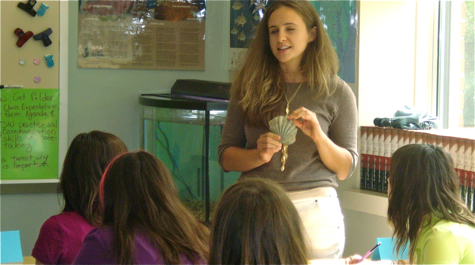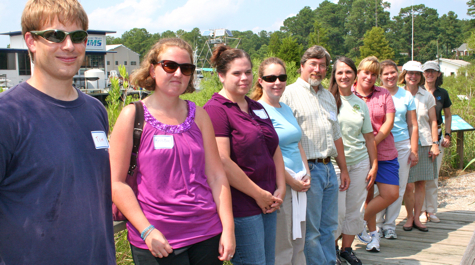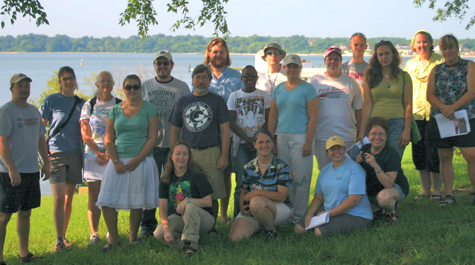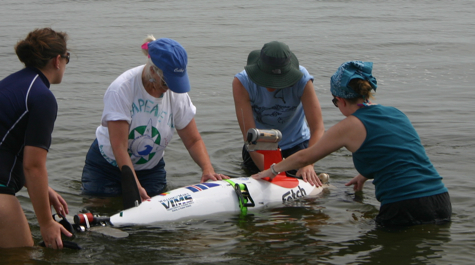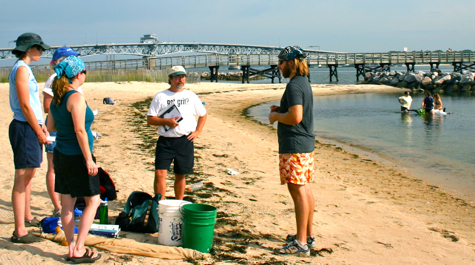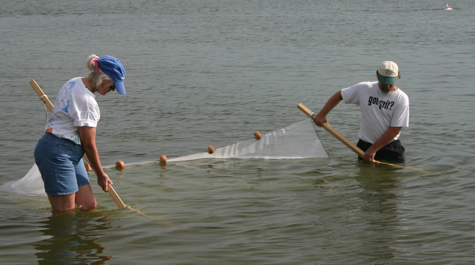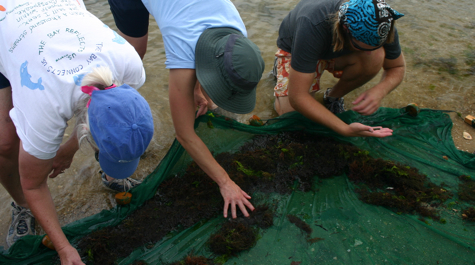VIMS begins long-term partnership with local schools
The Virginia Institute of Marine Science has begun a 5-year partnership with middle- and high-school teachers to enhance science instruction at 4 local schools.
The PERFECT program—for Partnership between Educators and Researchers for Enhancing Classroom Teaching—connects graduate students in VIMS’ School of Marine Science with teachers and pupils at Booker T. Washington Middle School in Newport News, Chesapeake Bay Governor’s School in Rappahannock, Page Middle School in Gloucester, and York High School in Yorktown.
The program, funded by the National Science Foundation, is the brainchild of VIMS professor Kam Tang, Graduate Dean Iris Anderson, and Virginia Sea Grant educator Vicki Clark.
Tang says the goal of the program is “to bring real-life scientists into classrooms in order to improve the K-12 curriculum and stimulate interest in science.” Another key benefit, he says, is to provide graduate students at VIMS with “outside-the-box” training in how to most effectively share their science with students and the public.
“Studies show that science and technology education in the U.S. is falling behind that of other developed countries,” says Tang. “One way to address this problem is to strengthen the connection between scientists and schools by giving grad students the opportunity and training to bring their research into classrooms. Our program will allow that to happen.”
Deborah Fields, Principal at Booker T. Washington Middle School, echoes Tang’s assessment. She says her teachers and pupils are “incredibly excited about learning from practicing scientists about their research quest.”
Patti Griffin, Principal of the Chesapeake Bay Governor’s School, adds that the program allows her teachers "to share with the fellows their expertise of what works in the classroom." She says the program is "absolutely wonderful—it provides tremendous opportunities for our students to learn from role models and explore career options. It's a real win-win."
VIMS faculty chose 9 grad student fellows for the program’s first year. Anderson says selections were based on “academic achievement, enthusiasm, and the match between student and teacher interests.”
Each fellow will spend 10 hours per week in the classroom gaining hands-on experience with their partner teachers and his or her pupils. The fellows will also attend workshops to enhance their communication and teaching skills, develop teaching materials that incorporate their own research, and provide their partner teachers with a summer research experience. Faculty advisors from VIMS will attend the fellows’ classroom sessions to provide feedback.
Most of the fellows are partnering with teachers in Life, Earth, or Environmental Science classrooms. Dan Dutton, a Master’s student in Fisheries Science at VIMS, is partnering with Sherry Pettyjohn, who teaches Biology and Chemistry at the Chesapeake Bay Governor’s School.
Dutton, who is studying bycatch issues in the Atlantic white marlin fishery, recently traveled with Pettyjohn to the White Marlin Open, a 4-day fishing tournament in Ocean City, Maryland. The pair collected tissues samples of both white marlin and round-scale spearfish, two species that are often confused. Back at VIMS, they ran genetic tests to verify the identifications made at the dock.
Pettyjohn says that “it will be great for my students to see a real-world application of the techniques they learn in class.” Dutton adds “It was great to see the enthusiasm of someone like Sherry who knows the concepts behind genetic studies but was unfamiliar with the procedures and techniques we use in our lab.” Pettyjohn plans to use the techniques learned at VIMS to modify her own teaching activities.
A more non-traditional partnership is between Ph.D. student Lila Rose and Kim Denmark, a 7th-grade English teacher at Booker T. Washington Middle School. Rose, who doubled majored in Geology and English before arriving at VIMS, has already begun reading the novels on Denmark’s class list in search of science “tie-ins.” One idea is to use Esperanza Rising, a Depression-era story of a young girl’s journey to the U.S., as a platform to learn about mapping with Google Earth. The students will also observe birds at a classroom feeder, and then write about them and the importance of Chesapeake Bay to migration patterns along the Eastern seaboard.
Rose says she applied for the program because “it’s important to be able to effectively explain the science I’m doing to other audiences.” She sees clear links between science and English. “The ability to carefully observe and describe are important to both fields,” says Rose.
Fields says that Rose and fellow graduate student Erica Holloman “have already been in the classroom, and we’re only three days into the school year. It’s like they were born to be here with the kids.” Holloman, who is studying the link between seafood consumption and mercury contamination, is partnering with 7th-grade science teacher Tim Jones.
The PERFECT program began with two-week courses for both the graduate fellows and teachers. In June, the fellows worked with Clark and colleague Carol Hopper Brill, Sea Grant marine science educators who have years of experience with local teachers, to learn about classroom management, lesson-plan writing, and other instructional techniques.
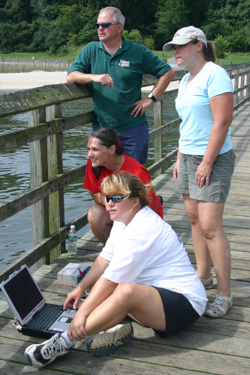 In August, the teachers gained information about marine science from the graduate fellows and VIMS faculty during classroom instruction and field trips. “The fellows showed the teachers how to do seining, trawling, and plankton tows,” says Anderson. “They also explored ecology and geology along the York River. The fellows were very enthusiastic, and the teachers loved it.” Several teachers plan to use a field guide produced by the graduate students with their own pupils.
In August, the teachers gained information about marine science from the graduate fellows and VIMS faculty during classroom instruction and field trips. “The fellows showed the teachers how to do seining, trawling, and plankton tows,” says Anderson. “They also explored ecology and geology along the York River. The fellows were very enthusiastic, and the teachers loved it.” Several teachers plan to use a field guide produced by the graduate students with their own pupils.
The four partner schools are diverse, including two that use a traditional science curriculum, and two with a special focus on marine and environmental science. “The schools also serve a high percentage of students traditionally underrepresented in science and technology fields,” says Tang. “That’s an important consideration given projections about the make-up of the U.S. workforce in coming decades.”
Tang notes that the PERFECT is the only scientist-teacher partnership in the Chesapeake Bay region to focus on marine science. “It provides invaluable teaching and learning experiences that go beyond conventional graduate training,” says Tang.
Continuing information on the partnership is available at vims.edu/education/teaching/gk12
Fast Facts
- Partnering schools: 4
- Number of fellows per year: 9
- Hours per week in the classroom: 10
- Fellowship duration: 1 year for MS; 1-2 years for PhD
2009 Graduate Fellows and Teaching Partners
| Fellow | Teacher | School | Subject |
| Erica Holloman | Tim Jones | BTW | Life Science |
| Lila Rose | Kimberly Denmark | BTW | English |
| Christian Hauser | Judith Gwartney-Green | Page | Life Science |
| Patrick McGrath | Sherry Rollins | Page | Life Science |
| Lindsey Kraatz | Kristin Lynn Kelly | York | Earth Science |
| Heidi Geisz | Amber LaMonte | York | Biology & Environmental Science |
| Daniel Dutton | Sherry Pettyjohn | CBGS | Biology and Chemistry |
| David Elliott | Sara Beam | CBGS | Marine Environmental Science |
| Noelle Relles | James Beam | CBGS | Fundamentals of Science |

